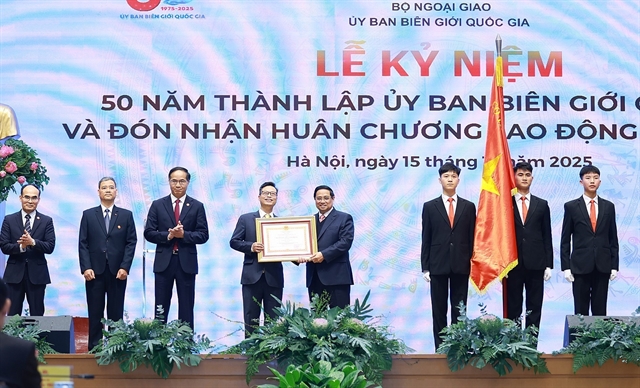 Economy
Economy

 |
| Nguyễn Hoài Nam, VASEP's deputy general secretary. — VNS Photo |
Although Việt Nam's seafood exports were estimated at 235,300 tonnes in the first two months of 2023, worth more than US$1 trillion, this represents a drop of 26 per cent over last year in volume and 32.9 per cent in value, according to data from the General Department of Việt Nam Customs.
However, the export market is expected to rise in the second quarter of 2023, though the recovery will not be as fast as in the same period last year. Việt Nam News reporter Tố Như spoke to Nguyễn Hoài Nam, deputy general secretary of the Việt Nam Association of Seafood Exporters and Producers (VASEP), to learn more about the expectation.
What do you think about the prospect of Việt Nam's seafood export to the Chinese market?
Vietnamese seafood producers are interested in the Chinese market because it is a large market and has grown continuously over the past five years. China’s imported fresh food products are worth around US$2 billion, accounting for more than 20 per cent of China's total import market share. This is a market that Vietnamese businesses can penetrate.
Compared to other countries such as Ecuador or India, Việt Nam is currently the largest supplier for wholesale markets in Guangxi, China. Guangxi is a strategic province, ranking in the top five of China's major localities that import seafood from Việt Nam.
What are the challenges that seafood businesses exporting to China face? How VASEP will support them?
Decrees 248 and 249 stipulate that the business community, including Vietnamese seafood enterprises, must register with the Chinese authorities. This is a regulation of the importing country, and we must comply.
However, some businesses have recently encountered significant challenges. When the registration procedures fail, they have to redo the process through the Vietnamese competent authority, the Agro Processing and Market Development Authority.
In the current era of digitalisation, the technology platform and registration process from the Chinese authorities are not fully supportive of exporting to countries like Việt Nam.
From the VASEP’s perspective, we hope that the Chinese authorities will pay more attention to this procedure so that the registration procedures will be more convenient in the future.
As you have mentioned, China and Guangxi are hugely targeted markets for Vietnamese seafood, which is also a high-income sector. What products do you think Vietnamese seafood businesses should focus on to win over the markets?
According to general statistics, shrimp is still the largest export commodity, valued at about $1 billion, while the total seafood export value to China was $1.61 in 2022.
Recently, shrimp has been a commodity that accounts for about 40-50 per cent of the total export turnover to the Chinese market, and this figure fluctuates from time to time. However, in 2022, this figure reached over 50 per cent.
In the first two months of 2023, Việt Nam's seafood exports to all markets decreased at a double-digit rate due to immense inflation in big countries. However, for the Chinese market alone, our seafood exports decreased by 7 per cent to nearly $160 million during the period.
In February, seafood exports to many markets declined, yet the Chinese market alone accounted for US$120 million, up 33 per cent.
In general, while trade with other markets is declining, the Chinese market is growing positively. This is a huge motivation. China is a promising destination that various trade associations, including those for seafood, are particularly interested in.
Guangxi Province is mainly interested in shrimp products and value-added products such as those made from swim bladders and fish skin, followed by pangasius and fresh products. This is an advantage for both sides.
With such an impressive market share as I just shared above, Vietnamese businesses should pay more attention to traders and border markets in Móng Cái in Quảng Ninh Province and Guangxi, China.
From last year to the beginning of this year, seafood businesses have encountered many difficulties. Will the negative trend end at the beginning of the second quarter?
It is hard to say.
Input costs are soaring. Meanwhile, inflation rates in many countries remain very high, resulting in lower imports.
In the first quarter of this year, seafood exports to other countries may be cancelled, interrupted, or slowed down. On the other hand, businesses still have to collect raw materials from farmers for processing and export.
These businesses are storing raw materials to serve the production needs of the second and third quarters, not for inventories.
However, this led to an overwhelming amount of debt that businesses had to pay to banks in the first quarter of this year. They are short on cash flows.
The bottleneck here is that we lack enough cash flow to pay the debts. Therefore, seafood enterprises do not wish for charge-offs, but they expect the Government and the State Bank (SBV) to have policies for debt rescheduling.
As a result, businesses have sufficient cash flows, collect raw materials from fishermen, and wait for positive signals from different markets, including China, which is forecasted to consume more starting in the second quarter.
Should businesses try to find ways to penetrate new markets or niche markets?
One of our six regular tasks is a trade promotion. In the current challenging context, if we reduce media, marketing, and trade promotion activities, we cannot connect with new markets.
Therefore, after attending the Seafood Expo North America in Boston (USA) this March, we will follow the world's largest seafood fair in Barcelona, which is expected at the end of April 2023. — VNS




